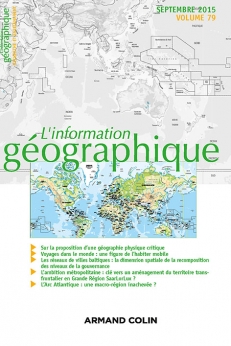
L'information géographique - Vol. 79 (3/2015)
Pour acheter ce numéro, contactez-nous
Recevez les numéros de l'année en cours et accédez à l'intégralité des articles en ligne.
Depuis 2009, la Grande Région SaarLorLux s’est fixé pour objectif de devenir une « Région métropolitaine polycentrique transfrontalière » (RMPT). Dans cet espace frontalier concentrant le plus de travailleurs frontaliers d’Europe (environ 210 000), cette ambition politique sert notamment de catalyseur au développement d’une stratégie commune d’aménagement du territoire qui, malgré une coopération déjà bien établie (initiée dans les années 1970), n’a pas encore vu le jour. Cette contribution prend cette apparente contradiction comme point de départ pour explorer les enjeux d’un positionnement métropolitain dans le contexte d’un aménagement du territoire transfrontalier. Pour ce faire, les multiples asymétries politiques, administratives et culturelles façonnant les rapports de force transfrontaliers sont mises en avant. Ensuite, les enjeux d’un positionnement métropolitain sont analysés de manière critique avant de faire le point sur deux réalisations institutionnelles récentes participant à l’opérationnalisation de la stratégie RMPT.
In 2009, the Greater Region SaarLorLux launched a strategy targeting the establishment of a “cross-border polycentric metropolitan region” (CBPMR). This political ambition aims at developing a cross-border spatial planning strategy in this area, which has the highest concentration of commuters in Europe (around 210,000). Despite longstanding cooperation (dating back to the 1970s), a cross-border planning strategy has not yet been established. This contribution critically reflects on this metropolitan ambition in order to grasp the challenges in establishing a cross-border spatial planning strategy. The article first investigates the complex institutional, political and cultural mismatches shaping cross-border power relationships. It then explores the bottlenecks behind the metropolitan ambition before addressing two examples of recent institutional instruments set up to operationalise the CBPMR strategy.
